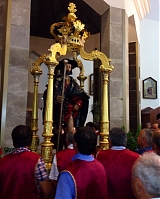Sanctuary of St. Rocco
Built in the '50 of 900, the current church substituted the previous one, which survived to the landslide of 1765. Numerous pilgrims and tourists visit the structure to ask for a grace to the pilgrim saint, especially in the summer on the occasion of the solemn celebrations. The original church was edified in the half of 600, probably because of the tremendous epidemic of plague that hit the Reign of Naples in 1654, causing death also in the zone of Chieti (as from the minutes of June 1761, during the pastoral visit of Mons. Nicolò Radulovich). Documentary evidences on the existence of a statue of St. Rocco in the village, date back to the jubilee of 1575 (Girolamo Nicolino, Historia della citta di Chieti, 1657).
A great part of the present structure, even if modern, was built with travertine local stone called "curly stone". The legend tells the passage of St. Rocco (French pilgrim known as the most invoked saint from the Middle Age above, as protector of the tremendous curse of plague) which, together with other hermits, was hosted in the castle of the village, property of the family of Orsini, and than transferred to the Colonnas of Rome. The manor was another place for accommodating the passing through pilgrims, which travelled to Rome or to the Adriatic route.
Cave and Fountain of St. Rocco
The popular belief tells that the pilgrim saint dwelled in a cave of the village where he made miraculous the spring gushing inside it. This place inspires a deep devotion because it narrates the hermitage and the survival of the young hermit, alive thanks to a dog which bring him some bread.















